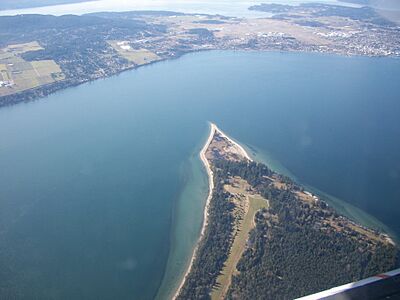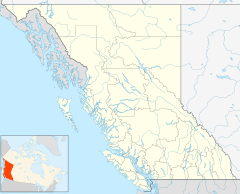James Island (British Columbia) facts for kids
Quick facts for kids
James Island
|
|
|---|---|
|
|
|
| Country | Canada |
| Province | British Columbia |
| Population
(2012)
|
|
| • Total | < 8 |
James Island is one of British Columbia's beautiful Gulf Islands. It sits in the Haro Strait, a body of water between Sidney Island and the coast of Vancouver Island. The island is quite close to Sidney, British Columbia.
James Island is about 2.4 kilometers (1.5 miles) from Vancouver Island. It is also about 145 kilometers (90 miles) from Seattle, Washington. The highest point on James Island is 145 meters (476 feet) above sea level. The island covers a total area of 315 hectares (778 acres). You can find sea-cliffs on the southern, western, and eastern sides of the island. The cliffs on the southern side are the tallest.
Contents
Naming the Island
In the SENĆOŦEN language, spoken by the WSÁNEĆ nations, the island is called P'AQwƎČ.
The island was named by early settlers around 1853. They named it after James Douglas. He was an important leader of the Hudson's Bay Company. He also served as the second governor of the Colony of Vancouver Island.
Later, in 1858, Captain Richards of the ship HMS Plumper officially adopted this name. Captain Richards was in charge of mapping the southern coast of British Columbia from 1857 to 1862.
Island History
James Island is part of the traditional lands of the Tsawout First Nation. A hereditary chief of the Tsawout, Louie Pelkey, was born on the island in 1860. Even though it's near some treaty areas, James Island itself is not part of a specific Douglas Treaty area.
Early Uses of the Island
In the early 1900s, James Island was a private hunting spot. Important people like Richard McBride, who was the Premier of British Columbia from 1903 to 1915, used to hunt there.
The Dynamite Plant
In 1913, a dynamite factory was built on the island. This factory was owned by a company that later became part of Canadian Explosives Ltd. This company then changed its name to Canadian Industries Limited (CIL) in 1927.
During World War II, a special part of CIL called Defence Industries Ltd operated the plant. The factory and many homes for its workers were moved to James Island from Nanaimo. At its busiest, the plant had 800 employees. Most of these workers lived in a small village on the island that had no car traffic.
The plant produced a lot of TNT during World War II, about 900 metric tons (992 short tons) each month. TNT is a powerful explosive. The TNT plant closed in 1977. In 1979, the factory buildings and the village were taken apart and removed from the island.
Modern Island Development
In 1994, Craig McCaw bought James Island for $19 million. He wanted to use the island for homes. However, because of its past as an industrial site, there were challenges in developing it.
Today, the island has been developed into a luxury resort. It includes a golf course, a place for yachts to dock, a ramp for seaplanes, and even an airstrip.
Craig McCaw has also focused on protecting the environment on James Island. For example, no insecticides are allowed. All power lines are buried underground. People on the island use electric cars and golf carts for transportation.
In 2009, James Island was the most valuable property in the Capital Regional District, worth almost $76 million. In June 2012, the island was put up for sale with an asking price of $75 million. However, it is no longer listed for sale.
Island Ecology
The island is part of the Coastal Douglas Fir Lowland. This is a type of forest ecosystem found in British Columbia.



